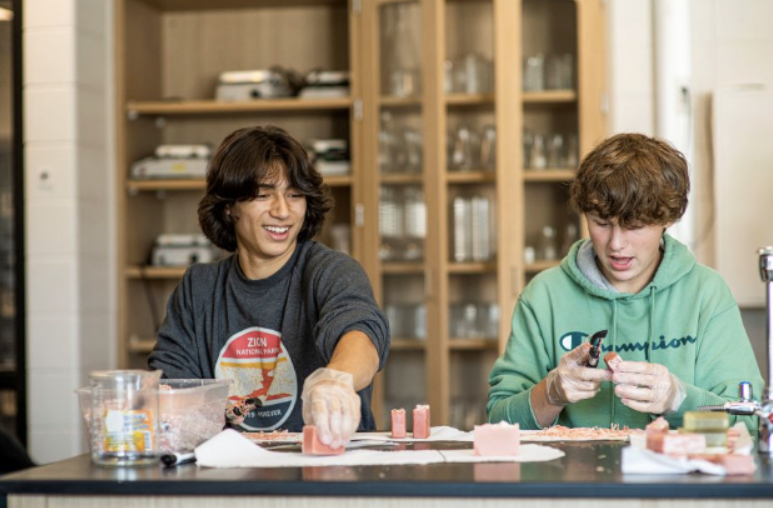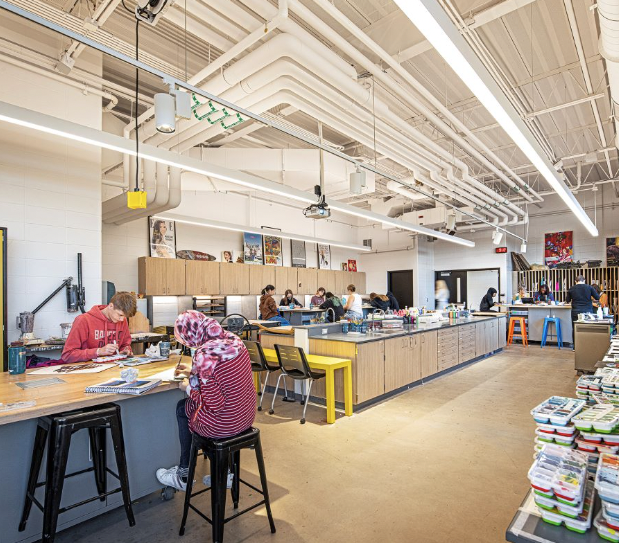Project-Based Learning Programs Support Creativity and Entrepreneurship in Specialized Space
Key Points
-
Programs that combine the development of core life skills and trained skills thrive in intentionally designed spaces.
-
Project-based education inspires students to pursue new ways of learning in and outside of a classroom setting.
-
Creating warm and inviting spaces that support existing curriculum while integrated into the current high school creates inclusivity.

By: Hannah Pier-Herendeen
Forest Hills Northern High School (FHN), located in Grand Rapids, Michigan is home to several nontraditional education pathways offered to students in the Forest Hills Public Schools district. Two of the district’s programs, Project NEXT and the STEM Academy, coexist within FHN and strive to bring the “real world” into the classroom and prepare their students for successful futures. These programs are thriving in a newly developed space, in response to their growth, that now reflects the innovative work being done by their students.
Project NEXT
FHN took a bold step to offer their students a new way of learning through a project-based program called Project NEXT in 2018. Project NEXT is a 4-year parallel path program of study that was driven by the school and teachers’ visions to provide students with hands-on and collaborative ways of learning. Educators participated in project-based learning training through the Buck Institute for Education to gain the knowledge and skills needed to support the curriculum. The program originally began as a pilot initiative in the media center with just a handful of students. At the time, a modest investment was made in the pilot program by designing and refreshing the school’s media center with new, flexible furniture more conducive to next-generation, collaborative learning.
As the program has grown in popularity and success, it was clear this type of learning required more dedicated space to continue. Redesigning the school’s west wing to accommodate those musts started with converting a courtyard into a central learning commons, known as the Design Center, which acts as the hub of the program. Project NEXT now supports over 90 students in the high school and continues to grow as students express interest in this new way of teaching and learning.
“This project was really unique because the architecture complemented the already established program and better supported the curriculum,” said GMB Project Lead, Chris Arntzen, about the project. “We were able to work with the district and teachers to create really intentional spaces based on the class work they had already practiced.”
The goal of Project NEXT is to prepare students for life through soft skills like communication, teamwork, public speaking, and independent thought. The specially designed spaces are intended to be multipurpose, flexible, and connected to achieve the program’s vision. Students in the program must identify and propose solutions to real-world problems, so spaces that fuel collaboration and creativity were essential. The Design Center includes a dedicated presentation area, an extension of a classroom set up for technology/computer lab overflow, and a mimicked coffee shop area. Next to the commons, each grade level has its own classroom pod of four classrooms and a breakout space. The pods can be interconnected for collaboration and co-teaching as needed.

“Students engaged in their learning tend to enjoy school more, retain their learning for a longer period, and build the necessary skills to succeed after high school,” said former Forest Hills North High School principal, Jon Gregory. “The new space allows for this type of learning to occur in a variety of ways due to the flexibility of the space and furniture. Students have commented on how easy it is for them to collaborate and engage with each other in their learning.”
STEM Academy
The Forest Hills STEM Academy is a program that is grounded in actionable learning and has been providing students with interactive learning opportunities since 2015. Coursework includes a thematic and interdisciplinary approach that gives students foundational skills and builds relevant connections in STEM education.
The original setup for the STEM Academy included a couple of science labs with connected instructional classrooms and refurbished classrooms that acted as maker spaces. With continued success in the program, and the addition of another hands-on learning program called Gone Boarding, the STEM Academy has found itself working alongside Project NEXT in the new Design Center. STEM Academy students can now split their time between more traditional academic classrooms and the commons area, which was designed with flexibility and multiple learning styles in mind.
One tangible outcome of the STEM Academy’s unique program is flourishing in the new space and turning their students into budding entrepreneurs. Handmade in the Hills is a soap business organized and maintained by sophomore STEM Academy students studying chemistry. Students are responsible for the development, packaging, marketing, and selling of soaps that come in different shapes, colors, and scents. Students are learning practical skills in manufacturing, mathematics, industrial arts, economics, and more from just this one portion of their curriculum. The success of this self-sustaining business also impacts students beyond just academics; it also develops their core life skills like teamwork and problem-solving.
“A lot of our students come back (to Forest Hills) and say that what they learned in presenting, collaborating, communicating really made a difference in their post-graduation life,” said Austin Krieg, STEM Academy chemistry teacher who leads Handmade in the Hills. “Giving students the opportunity to learn where they will do their best work is a unique aspect of our programs.”
One of the goals of project-based learning is to create cross-pollination between disciplines and build cohesion between curriculums in art, science, and beyond. The Design Center and adjoining science labs, art room, and woodshop can be used by any student at Forest Hills, creating a sense of unity throughout the school and creating opportunities for everyone.
“There is something for every student,” added Krieg.
Hannah Pier-Herendeen is the content writer and storyteller at GMB Architecture + Engineering.


0 Comments
Leave a Comment
Your email address will not be published. All fields are required.